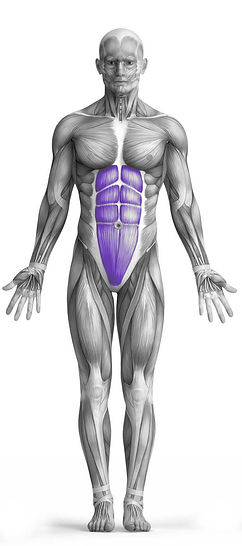Suspended Reverse Crunch 101 Video Tutorial
0

Exercise Synopsis
Target Muscle Group
Abs
Execution
Isolation
Force Type
Core
Required Equipment
Bodyweight
Fitness Level
Intermediate
Variations
Alternatives
Timer
Hour
Minute
Second
Stopwatch
00:00:00:00
Overview
The Suspended Reverse Crunch is a bodyweight exercise that primarily targets the abdominal muscles, with secondary engagement of the obliques and lats. In this exercise, the individual starts by suspending themselves in a hanging position, typically using a pull-up bar or suspension straps. From this position, they contract their abs to lift their legs upward towards their chest while keeping their upper body stable. This movement emphasizes the lower portion of the abdominal muscles, helping to strengthen and tone the core. The suspended nature of the exercise adds an element of instability, requiring greater control and coordination to execute the movement effectively. As it utilizes only body weight, it can be performed virtually anywhere with the appropriate equipment, making it a versatile addition to any workout routine aimed at improving core strength and stability.
How to Perform
Begin by hanging from a pull-up bar or suspension straps, ensuring your arms are fully extended and your body is in a straight line.
Engage your abdominal muscles as you lift your legs upward towards your chest, keeping them straight and together throughout the movement.
Pause momentarily when your knees reach chest level, focusing on fully contracting your abs to maximize muscle engagement.
With control, slowly lower your legs back to the starting position, maintaining tension in your abs and preventing your back from touching the ground.
Perform the exercise for the desired number of repetitions, maintaining a steady pace and focusing on controlled movements to effectively target the abs, obliques, and lats.
Ensure to breathe steadily throughout the exercise, inhaling during the lowering phase and exhaling as you lift your legs, to support muscle function and maintain energy levels.
Additionally, focus on stabilizing your upper body and minimizing swinging or momentum to isolate the target muscle groups effectively.
As with any exercise, listen to your body and adjust the intensity as needed to avoid overexertion or injury, and consult with a fitness professional if you have any concerns or limitations.
★ Bonus: For exercises that involve external weights (such as dumbbells, barbells, or machines), the One Rep Max (1RM) calculator can help you estimate your maximum lifting capacity. Use it to track your strength progress and adjust your training for optimal results.
Tips
Emphasize Controlled Movements: Resist the temptation to rush through the Suspended Reverse Crunch; instead, prioritize deliberate and controlled movements. Lower your legs slowly to fully engage your abdominal muscles, avoiding the common error of allowing them to drop quickly, which not only diminishes effectiveness but also increases the risk of injury.
Focus on Breathing: Proper breathing technique is crucial for optimal performance during the exercise. Inhale deeply as you lower your legs and exhale steadily as you lift your knees towards your chest. This rhythmic breathing pattern enhances control and stability throughout the movement, aiding in maintaining proper form and maximizing muscle engagement.
Minimize Momentum: Steer clear of relying on momentum to execute the exercise. Momentum can compromise the isolation of target muscle groups and detract from the effectiveness of the workout. By prioritizing controlled movements and avoiding swinging or jerking motions, you can ensure that the emphasis remains on the abs, obliques, and lats, resulting in a more efficient and beneficial workout session.
How Not to Perform
Avoid Swinging: One common mistake is swinging the legs to generate momentum. This not only reduces the effectiveness of the exercise but also shifts the focus away from the targeted muscles. Keep your movements controlled and precise to prevent swinging and ensure maximum engagement of the abs, obliques, and lats.
Don't Use Excessive Leg Momentum: Refrain from relying solely on the momentum generated by swinging your legs to lift your hips. Instead, focus on initiating the movement from your core muscles, particularly the lower abs. Engage your abs to lift your legs, rather than using momentum, to effectively target the intended muscle groups.
Avoid Arching Your Back: Another common error is arching the lower back excessively during the movement. This not only places undue strain on the spine but also reduces the effectiveness of the exercise by shifting the emphasis away from the abs. Keep your back flat against the ground or stable surface throughout the exercise to maintain proper form and maximize muscle activation in the abs, obliques, and lats.
Don't Hold Your Breath: It's important to maintain a steady breathing pattern throughout the exercise to optimize performance and prevent energy wastage. Avoid holding your breath as this can lead to decreased oxygen flow to the muscles and decreased endurance. Instead, inhale during the lowering phase and exhale as you lift your legs, maintaining a consistent rhythm to support muscle function and focus.
Avoid Overarching Your Neck: Lastly, be mindful of your neck position during the exercise. Avoid craning or overextending your neck, as this can strain the cervical spine and detract from proper muscle engagement in the abs, obliques, and lats. Keep your neck in a neutral position, with your gaze directed towards the ceiling or slightly forward, to ensure alignment and minimize the risk of injury.
Variations
Variations of fitness exercises refer to different ways of performing a specific exercise or movement to target various muscle groups, intensities, or goals. These variations aim to challenge the body differently, prevent plateaus, and cater to individuals with varying fitness levels.
Alternatives
Alternative exercises in fitness refer to different movements or activities that target similar muscle groups or serve the same training purpose as the primary exercise. These alternative exercises can be used as substitutes when the original exercise is unavailable or challenging to perform due to various reasons such as equipment limitations, injuries, or personal preferences.








